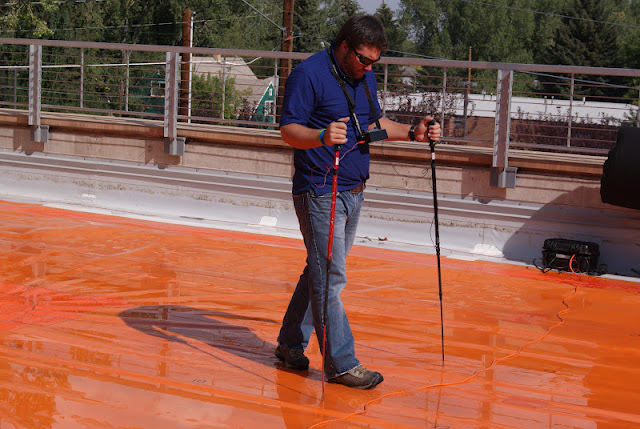The roof passed its first leak test with flying colors (see "Moment of truth") and its second, and its third. These last two were to find leaks in
the top membrane, and were, like the first, accomplished by flooding the roof
and letting the water stand for at least 24 hours. But—how to tell if there’s a leak in the top
membrane when we know there’s none in the bottom? A leak in the bottom membrane
would result in water in the collection room (Oh No!), while a leak in the top
membrane would only mean water between the membranes. Invisible? Yes.
Undetectable? NO!
The roof was designed and built with a leak detection system
specifically to pick up leaks in the top membrane BEFORE there’s a hole in the
bottom membrane.
Here’s how it works:
Between the two membranes is a screen that looks like
ordinary window screening (see the screen in the photo below). A wire is attached to the screen, so that it can be
electrified. Above the top membrane there are also wires—generally around the
periphery, including around the drains—so that when the surface of the membrane
is covered with water, and the wires are plugged in, there is a continuous
electric field above the membrane. The electric fields of the screen below and
the water above should be completely separate, unless there’s a hole allowing
water to connect them.
Here’s a photo of Adam (International Leak Detector) looking
for leaks. The two poles are used to measure the current on the surface. Leaks
cause a change in resistance, which is read on the meter around Adam’s neck.
Should there be a hole, it can be pinpointed with the two poles.
The test took only about 20 minutes, as Adam walked back and
forth. There was a short period of suspense when he stopped walking and poked
around, but it turned out to be water running over the lip of the drain, not
water running through a hole in the membrane. What a relief!
To maintain the roof from now on, we’ll be hiring Adam’s
employer now and then to re-run the test. They can do this through up to six
feet (!) of material above the membrane, so long as the membrane surface is
thoroughly wet. This way, we’ll never again discover a leak using the
flood-the-collection-room detection system.
Written by Dorothy Tuthill, Berry Center



No comments:
Post a Comment
Please leave us your feedback here!